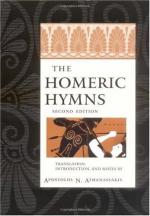The Greeks naturally identified Demeter and Dionysus with Isis and Osiris. There were analogies in the figures and the legends, and that was enough. So, had the Greeks visited America, they would have recognised Demeter in the Pawnee Earth Mother, and Persephone or Eubouleus in Chibiabos. To account for the similarities they would probably have invented a fable of Pawnee visitors to Greece, or of Greek missionaries among the Pawnees. So they were apt to form a theory of an Egyptian origin of Dionysus and Demeter.
M. Foucart, however, argues that agriculture, corn-growing at least, came into Greece at one stride, barley and wheat not being indigenous in a wild state. The Greeks, however, may have brought grain in their original national migration (the Greek words for grain and ploughing are common to other families of Aryan speech) or obtained it from Phoenician settlements. Demeter, however, in M. Foucart’s theory, would be the Goddess of the foreigners who carried the grain first to Hellas. Now both the Homeric epics and the Egyptian monuments show us Egypt and Greece in contact in the Greek prehistoric period. But it does not exactly follow that the prehistoric Greeks would adopt Egyptian gods; or that the Thesmophoria, an Athenian harvest-rite of Demeter, was founded by colonists from Egypt, answering to the daughters of Danaus. {84} Egyptians certainly did not introduce the similar rite among the Khonds, or the Incas. The rites could grow up without importation, as the result of the similarities of primitive fancy everywhere. If Isis is Lady of the Grain in Egypt, so is Mama in Peru, and Demeter need no more have been imported from Egypt than Mama. If Osiris taught the arts of life and the laws of society in Egypt, so did Daramulun in Australia, and Yehl in British Columbia. All the gods and culture heroes everywhere play this role—in regions where importation of the idea from Egypt is utterly out of the question. Even in minute details, legends recur everywhere; the phallus of a mutilated Australian being of the fabulous “Alcheringa time,” is hunted for by his wives; exactly as Isis wanders in search of the phallus of the mutilated Osiris. {85a} Is anything in the Demeter legend so like the Isis legend as this Australian coincidence? Yet the Arunta did not borrow it from Egypt. {85b} The mere fact, again, that there were Mysteries both in Egypt and Greece proves nothing. There is a river in Monmouth, and a river in Macedon; there are Mysteries in almost all religions.
Again, it is argued, the Gods of the Mysteries in Egypt and Greece had secret names, only revealed to the initiated. So, too, in Australia, women (never initiated) and boys before initiation, know Daramulun only as Papang (Father). {85c} The uninitiated among the Kurnai do not know the sacred name, Mungan-ngaur. {85d} The Australian did not borrow this secrecy from Egypt. Everywhere a mystery is kept up about proper names. M. Foucart seems to think that what is practically universal, a taboo on names, can only have reached Greece by transplantation from Egypt. {86a} To the anthropologist it seems that scholars, in ignoring the universal ideas of the lower races, run the risk of venturing on theories at once superficial and untenable.




